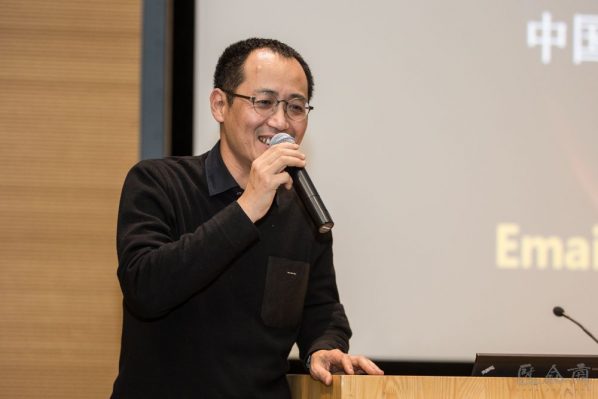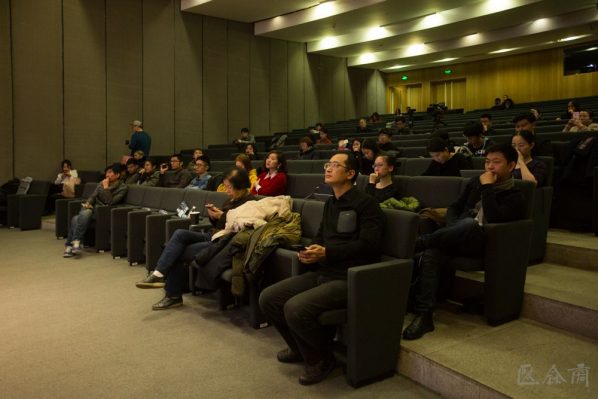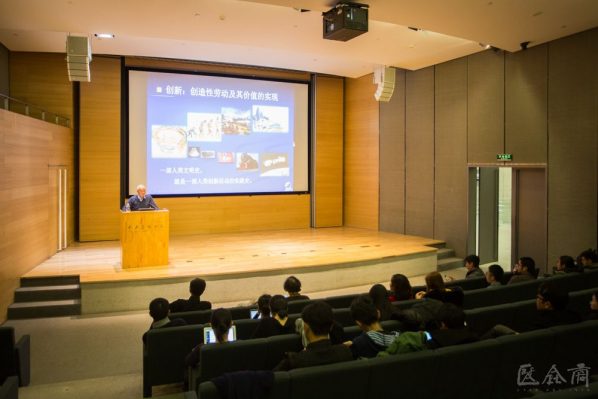
At 6:30 pm on December 25, 2017, Teng Jiwen, a member of the Institute of Geology and Earth Sciences, Chinese Academy of Sciences, gave the audience an introduction to the natural sciences at the Auditorium of CAFA Art Museum and it was entitled the “Earth in Turmoil – The Exchange of Matter and Energy Inside the Earth and the Deep Motive Processes”, presided over by Qiu Zhijie, Dean of the School of Experimental Art, CAFA.
First of all, Teng Jiwen introduced the concept of geophysics to the audience. Geophysics includes the gravitational field, magnetic field, electromagnetic induction field, geological wave field, temperature field and radiation field, etc., and he took “Up to the azure vault and down to deepest place, nor above nor below could he e’er find her trace”, a sentence from “The Everlasting Regret” by Bai Juyi, to summarize the geophysics, because the object of geophysical research is invisible, it is necessary to cross the horizon to touch the dynamic pulse of matter movement inside the earth. At this lecture, Teng Jiwen started from the geophysical perspective to introduce the “turmoil” inside the earth, that is, the movement inside the earth.

The lecture was presided over by Qiu Zhijie, Dean of the School of Experimental Art, CAFA
It is of a momentous significance to understand the movement inside the earth. Teng Jiwen said that China has achieved a rapid industrialization and the economy has taken off, so that it has consumed a lot of resources and energy. However, although China is large, our mineral resources are very scarce, so that, it is necessary to ask for resources and energy from the interior of the earth. On the other hand, the earth is not only the place where energy resources are supplied, but also the source of earthquakes, fires and other natural disasters. The earth is also the only place where human beings live. The surface resources support the life system for many hundreds of millions of years, expanding living space and improving the support environment have become the inevitable choices of human beings. Therefore, the real process of drawing resources from the depth of the earth and exploring the gestation, occurrence and development of the earth disasters has become the demand for the sustainable development of human beings, and the first step of all these needs is to understand the movement inside the earth.
How does the interior of the earth move? We are familiar with the continental drift which is the earth movement. In addition, the earth’s movement also includes submarine expansion, transform faults, mantle convection. Teng Jiwen gave a detailed account of these earth movements to the audience at the lecture. Teng Jiwen explained that, the heat energy located in the depths of the mid-ocean ridge at the bottom of the sea continues to rise, the heat value in the process of rising, and the matters located in the sides of the mid-ocean ridge symmetrically moving to both sides; the mid-ocean ridge is also not calm, and it is slowly broken off by the force, which resulted in the happening of a series of earthquakes in the broken place. It has a constant convection of matters in the mantle, which has caused the earth to constantly change, which has caused the drifting of continents and the expanding of the seafloor.

View of the lecture
Teng Jiwen said that the current world map has been formed because of the continuous movement of the earth. In fact, the earth can be divided into six major sections: the Eurasian Plate, the Americas Plate, the Africa Plate, the Pacific Plate, the Australian Plate and the Antarctic Plate, between plates there are boundary zones, which are high-frequency seismic places. China is an earthquake-prone country. The entire country is surrounded by seismic zones and affected by the earthquakes in the Mediterranean, Himalayas, South Asia and the Pacific Rim. The earthquakes do not only cause social and economic losses, they also bring permanent changes to the natural landscape as well as bringing distress to people. Teng Jiwen believes that the world has entered a period of intense earthquake activity.
Can the earthquake be predicted? There are two different groups of thought in academic terms: one group thinks that the earthquake is predictable and one group considers it unpredictable. One group that is engaged in engineering believes that as long as the strengthening of the seismic strength of the building and bridge construction, we can prevent earthquakes to some extent; while another group believes that reinforcement work is necessary, and it is necessary to find ways to predict earthquakes, to benefit humanity. Teng Jiwen said: “I think earthquake prediction is a scientific problem because we must know the time, place, and size of the major earthquakes. We must also know the probability of earthquakes before the legal department issues a prediction.

View of the lecture
Earthquake prediction is really difficult to complete, and where is the difficulty located? “First of all, the occurrence and development of a strong earthquake is the result of a strong exchange of material and energy within the earth. Therefore, how to establish mathematical and physical equations in the study of the earth’s interior and the state of material movement?” Teng said that, “The hardest part is that it is difficult to get into the earth. The earthquakes are generally divided into shallow earthquakes, middle earthquakes and deep earthquakes, and the deepest earthquakes can reach 700 kilometers in depth, while the shallow earthquakes are the ones that are more damaging than the others, and it reaches less than 33 km in depth. However, at such a depth, we are unable to detect them because of the limitations of the conditions, it is impossible to understand the properties of the medium and its tectonic setting near the seismic origin.” In addition, it is difficult to find the law of occurrence and development of earthquakes from the large earthquakes that have occurred, because the repetition rate is very low and the physical mechanisms of earthquakes are different. Teng Jiwen believes that these factors have caused great difficulties in earthquake prediction.
Even though earthquake prediction is very difficult, there are also some successful examples, such as the earthquake prediction of Haicheng in Liaoning Province, China and the earthquake prediction of the San Andres area on the west coast of the United States. To conclude, Teng Jiwen said that, “The eternal mystery of the world lies in its comprehensibility. I think earthquakes and earthquake prediction are also understandable, even if it is only 10% of the hope, we have to continue. As long as the global seismologists, geophysicists and academics of the related fields try their best, I think it will be able to succeed.”
Text by Zhong Yuwei, translated by Chen Peihua and edited by Sue/CAFA ART INFO
Photo by Hu Sichen/CAFA ART INFO




























